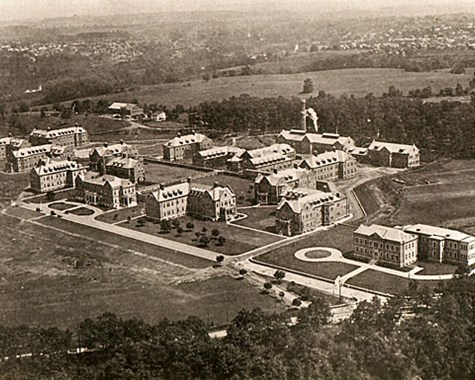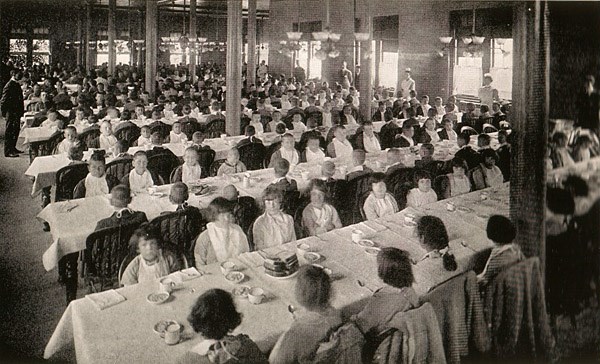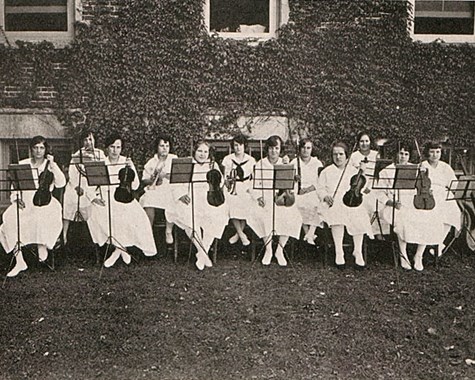Brief History of Institutionalization in Pennsylvania
In 21st Century Pennsylvania, the institutionalization described in 10 Days in a Madhouse may seem irrelevant to or distant from many of our lives. However, Pennsylvania has been, and continues to be home to several well-known institutions for people living with mental illness, as well as those living with intellectual and developmental disabilities. Due in large part to the tireless work of people with intellectual and developmental disabilities and their family members, community living with support is now an option. Audience members are encouraged to reflect on our local history, and consider common themes raised in 10 Days in a Madhouse. For example, Nellie and Lizzie were often infantilized by Dr. Blackwell. Similarly, Pennhurst housed both adults and children, but history informs us that all residents were referred to as “the children”, regardless of their age.
Get to know these historical event in Pennsylvania's history:
January 1897: Polk Center Opens
The Polk Center becomes the first state-operated institution for persons with intellectual disabilities in Polk, PA.
January 23, 1903: PA Legislature Authorizes Pennhurst
The PA Legislature authorizes the creation of the Eastern State Institution for the Feeble-Minded and Epileptic, the second such state-operated facility.
November 23, 1908: Pennhurst Patient Number 1
He is listed as "Patient number 1," a practice that was carried forward for all of Pennhurst's over ten thousand residents. For many parents, there was no other option in place to help with a disabled child than to send them to Pennhurst.

1912: Problems from the Start
From the outset, Pennhurst was overcrowded. Designed for epileptics and persons with intellectual and developmental disabilities, there was tremendous pressure to admit many different persons whom society, steeped in the eugenics movement, wanted removed from the gene pool, including immigrants, orphans, criminals, etc. But even the stated mission of Pennhurst - to house epileptics and 'the feeble-minded' - came under fire from within the institution as early as 1912.
1913: Commission for the Care of the Feeble-Minded
The PA Legislature, partially in response to concerns raised by the Pennhurst Board of Trustees, appoints a Commission for the Care of the Feeble-Minded. The Commission's conclusions included a statement that the feeble-minded were "unfit for citizenship' and that they posed a "menace to the peace." They recommended a program of custodial care to "break the endless reproductive chain."
1938: Embreeville State Hospital opens in Chester County, Pennsylvania
1949: Pennsylvania ARC Founded
The Arc is the largest advocacy organization in the United States for citizens with intellectual and developmental disabilities, and their families. The Arc of Pennsylvania is the state chapter of The Arc.
The Arc's mission is to work to include all children and adults with intellectual and developmental disabilities in every community. They promote active citizenship and inclusion in every community.

1955: Pennhurst population peaks at 3,500 individuals
1966: Mental Health & Mental Retardation Act passed
A new Mental Health & Mental Retardation Act is passed by the Pennsylvania Legislature. For the first time, it authorizes the provision of some services in community settings and establishes a network of county-managed "base service units" that would serve as "gateways" to the service system.
1968: “Suffer The Little Children”
Bill Baldini's Suffer The Little Children(1968) Conditions at Pennhurst are exposed in a five-part television news report anchored by local CBS correspondent Bill Baldini. While this is the first time that conditions in the facility have been shown to the general public, it is not the first "expose" of Pennhurst's failings. Numerous newspaper articles, legislative inquiries and other investigations have been focused on Pennhurst over the decades, beginning shortly after its opening.
1971: PARC v. Commonwealth of PA is filed in Federal District Court
In their “right to education” lawsuit, the PARC challenged the constitutionality of a state law allowing exclusion of children with intellectual disabilities from school. The case was resolved in 1972 in a consent decree establishing the right of all children with intellectual disabilities to attend public schools.
May 30, 1974: Halderman v. Pennhurst Filed
Landmark civil rights case Halderman v. Pennhurst State School is filed in the U.S. District Court for the Eastern District of PA by a the mother of a Pennhurst resident. The case would eventually reach the United States Supreme Court. The case is assigned to District Judge Raymond Broderick.
October 5, 1975: Public Law 94-103
The Federal Developmental Disabilities Assistance and Bill of Rights Act (P.L. 94-103) is signed into law. It establishes a system for protection and advocacy organizations in each state and enumerates certain rights for persons with developmental disabilities.

APRIL 1, 1977: Halderman v. Pennhurst trial
From April 1 1977 to June 1 1977, Halderman v. Pennhurst is tried. The Honorable Raymond J. Broderick rules in favor of the residents, declaring that forced institutionalization of persons with disabilities is unconstitutional. The District Court determined that Pennhurst provided "such a dangerous, miserable environment for its residents that many of them actually suffered physical deterioration and intellectual regression during their stay at the institution."
1979: Pennhurst Longitudinal Study
From 1979 to 1985, The Pennhurst Longitudinal Study finds that Pennhurst residents who moved to the community are "better off in every way we know how to measure." Before the relocation of residents, 60% of families of Pennhurst residents opposed the residents leaving Pennhurst; six months after relocation, more than 80% of the same families came to agree that relocation had been the right decision (quotes are from Judge Broderick's opinion of 2/6/98).
1980: Embreeville State Psychiatric Hospital closes, but a State Center for residents with intellectual disabilities remains operational.
JUNE 18, 1982: Romeo v. Youngberg
The U.S. Supreme Court rules in the case of Romeo v. Youngberg that the Constitution imparts a right to "minimally adequate treatment" for people involuntarily committed to state institutions. The Court defines the rights of such involuntarily committed persons to a right to be free from "unreasonable bodily restraints" and to a "reasonably safe environment and whatever minimal training might be required to protect those interests.
1984: Final Settlement Agreement
Final Settlement Agreement between the Halderman v. Pennhurst parties provides for the closure of Pennhurst. The agreement was approved by the District Court in April, 1985.
December 1987: Pennhurst officially closes.
January 1994: Civil Rights case is filed by disabled residents of Embreeville State Center (Coatesville, PA)
May 1, 2023: Polk State Center closes
